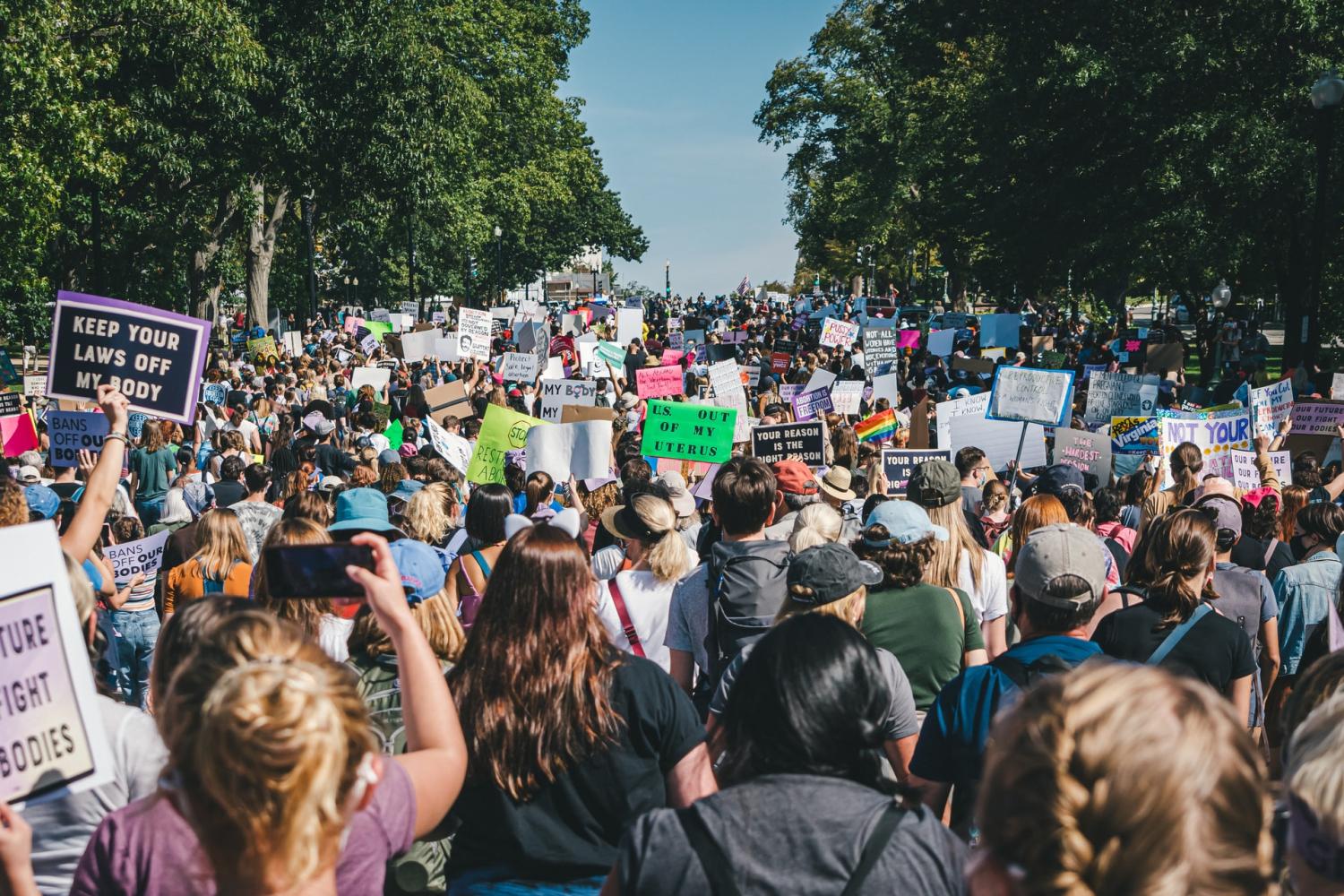Abortion Fight Forces a Reckoning For America’s Corporations


A rally for abortion rights in Washington, D.C., fall 2021
Leading U.S. corporations that profess to support human and civil rights were put on the spot last week, when the U.S. Supreme Court announced its final decision in the Dobbs abortion case. Some business leaders tried to control the damage by taking steps to ensure their employees of equal access to company-wide health benefits. However, a storm is coming, as employee and shareholder activists gear up for the fight of the century.
Business leaders can wield employee health plans as shields…
Salesforce and several other companies set the template for benefits-based action last fall. The company guaranteed travel support for its Texas employees seeking abortions out-of-state after the state's legislature passed new restrictions on abortion access.
Since then, the trickle has turned into a flood. A leaked draft of the Dobbs opinion set the wheels in motion several weeks ago, and some corporations were already prepared to take a stand.
According to a list maintained by Reuters, so far two dozen leading corporations have added out-of-state travel benefits for abortions or have stated that their existing benefits already cover out-of-state medical care.
So far, the list mainly includes financial and tech firms such as JPMorgan Chase, Citigroup, Goldman Sachs, Meta, Uber, Yelp, DoorDash and Microsoft, among others. However, entertainment companies (Netflix, Disney) also make an appearance, along with retailers (Starbucks, Kroger) and consumer brands (Levi Strauss, Gucci).
…at least for now.
Corporations may appear to be on firm ground by offering travel benefits. They position it as a matter of fairness, providing all employees with the same access to their health benefits regardless of where they live.
However, if corporations are placing the bar at consistency, the earth is already moving under their feet. The fairness argument is its own undoing. It gives oxygen to Republican office holders, and their allies on the Supreme Court, who are already working towards a national abortion ban.
If these corporations are looking for inter-state consistency, they could very well get it, just not in the way they anticipated.
Editor's note: Be sure to subscribe to our Brands Taking Stands newsletter, which comes out every Wednesday.
In addition, now that anti-abortion activists have the Supreme Court in their pocket, they can turn their full attention to changing state policies that still uphold the right to manage one’s own pregnancy.
As more states impose more restrictions, out-of-state travelers will strain medical resources in the remaining abortion-rights states. Concerns have already been raised over longer wait times for abortion services, resulting in increased risk to the pregnant person. The impacts could ripple out to impact services for residents in abortion-rights states as well as those traveling for an abortion.
After last week’s ruling on abortion, corporate citizens need to look in the mirror…
After a generation of corporate happy talk on diversity, equality and inclusion, the Dobbs decision has suddenly slammed the sledgehammer of reality on their heads. Many of them deserve it, because many of them they have provided the financial backing that leveraged Republican candidates into statehouses and the halls of Congress, ultimately providing former President Donald Trump with the opportunity to cement a 6-3 far-right, anti-abortion majority on the Supreme Court.
The organization Equity Forward has been tracking political contributions by corporations in support of anti-abortion lawmakers. They identified some of the best-known names in DEI — AT&T, Boeing, Coca-Cola, Comcast, Delta Airlines, General Motors, Google, Johnson & Johnson, Lyft, Mastercard, Microsoft, PepsiCo, Pfizer, Uber and Walmart — as significant contributors to the anti-abortion movement.
The blowback from two-faced political donations is a relatively new risk on the corporate risk manager’s to-do list. As described last February by Dorothy S. Lund and Leo E. Strine in the Harvard Business Review, much of the problem is due to the 2010 Citizens United Supreme Court decision, which opened the floodgates on corporate political donations.
In particular, Lund and Strine cite Google for signing on to a corporate voting rights letter last April, while at the same time the company “had quietly funded a ‘policy working group’ on ‘election integrity’ with the Republican State Leadership Committee.”
That is just one case among many. Lund and Strine also took note of a 2020 report containing “abundant examples” of companies that “donate to help elect candidates they hope will do their industry’s bidding or support a specific cause, even as they publicly advocate for the opposite stance.”
…and stop shooting themselves in foot.
Lund and Stine also suggest that the bottom-line benefits of political donations are not as straightforward as they may seem.
“Emerging evidence suggests that [political donations] can destroy value by suppressing innovation and distracting managers from more-pressing tasks,” they write. “Perhaps most important, political donations greatly heighten corporate risk.”
“In an era when customers, employees, and investors are increasingly scrutinizing companies’ records on employee, environmental, social, and governance issues ... the threat of blowback from political contributions has become too great for executives to ignore,” they add.
That was a prescient warning, but it has come far too late now that Dobbs has set the wheels in motion. Corporations that support Republican candidates and other anti-abortion lawmakers are now faced with the potential for an unprecedented backlash as millions of consumers wake up to the fact that all of their pregnancies, intended or not — and ultimately, all of their menstrual cycles — are now under the thumb of state machinery and self-appointed community police, thanks to a 6-3 majority on the Supreme Court consisting solely of Republican-nominated justices.
The fight of the century is just beginning
So, what’s in store for corporate crisis communicators? For starters, the consumer activist movement sparked by grassroots organizations like Sleeping Giants and Grab Your Wallet has already taken new form in at least one consumer-friendly app aimed at directing grassroots firepower against corporations that fund anti-abortion lawmakers, organized by Equity Forward under the name “Defund the Bans.”
Employee activist organizations have also become powerful forces on issues ranging from immigrant rights to climate change. Corporations can expect blowback from that quarter as well.
In addition, shareholder activism is also on the rise. An effective movement has already coalesced around climate change, and that is just the beginning. Last year, the U.S. Securities and Exchange Commission (SEC) changed its policy to provide more opportunity for shareholders to force a vote on social issues. It’s a safe bet that abortion will be one of them.
“Last year, the SEC shifted its policy on ‘no-action’ letters — essentially green lights for companies to cast aside shareholder proposals without fear of an enforcement action down the line—saying it would start factoring in broader social policy considerations when evaluating corporate requests to reject proxy proposals,” Bloomberg Law explained last May, which took note of at least three companies facing votes on proxy proposals related to abortion access: Walmart, Lowe’s and TJX.
Corporations can ignore the coming wave of activism at their own peril, or they can work with consumers, clients, employees, and shareholders to ensure that the right to manage one’s own pregnancy is cemented into the law of the land.
Image credit: Gayatri Malhotra via Unsplash
Your ‘Great Resignation’ Music Playlist Must Start with Baby Queen


She’s the recording artist you probably haven’t heard of yet, but London-based Arabella Latham — better known by her stage name, Baby Queen — will soon enough be taking this side of the pond by storm. In the queer community, she already has, as her songs from Netflix’s Heartstopper soundtrack have seen a huge boost in streams since the series launched in late April. Her two songs in the series' first episode are among the reasons why the show gets you hooked, and fast.
Born and raised in Durban, South Africa, Latham felt her aspirations for a music career would eventually stall in her home country. So she moved to the U.K. at the age of 18 and soon started work at the Rough Trade East record shop in London. Knowing zero people in the recording industry at first, she scrambled however she could to network within London’s music scene. Meanwhile, she constantly scribbled ideas of lyrics on sticky notes, many of which ended up on what her co-workers called “Bella’s Wall” at the store. The struggle went on for several years, as she hit rough patch after rough patch. Then, to top it off, she lost her job at Rough Trade when the pandemic hit. But several weeks after lockdowns started, Baby Queen signed her first recording deal with Polydor Records.
There’s far more to Baby Queen than her quick rise to stardom. Countless profiles and interviews sum her up as embodying the hopes — and anxieties — of Gen Z. But her music can also resonate with anyone who has become part of, or is thinking of joining, the so-called “Great Resignation," as her lyrics express exasperation with a toxic workplace, social media, homophobia, gender tropes, beauty standards and dismissive attitudes toward mental health.
Editor's note: Be sure to subscribe to our Brands Taking Stands newsletter, which comes out every Wednesday.
Let’s start with one of her breakout songs, “Internet Religion,” which is as much about the impact (or lack thereof, despite what the press releases say) that many of our institutions — including the business community, often has on society — as the lyrics speak about Gen Z angst:
Death and guns and beating the gay kids up
It doesn't happen to you, so why give a f---?
If you can go online just to become
The identity that you construct
Yeah, let's warp the standard of beauty
So none of our little sisters want to eat
Yeah, that's f---ing cool and it's a pity
We can't Facetune personality…
While we’re on the subject of angst and for those who still don’t understand what’s driving Gen Z’s mistrust of our institutions, including technology and media, then be sure to favorite “Narcissist” on YouTube or your preferred streaming app:
When I was just a girl, I read a magazine
It said, "You can have the world if you look pretty
But you'll never be enough, so avoid humiliation
And stop looking for love when all you need is validation"
So I grew up kind of hating myself
And letting all you m-----f-----s monetize my mental health
By making me believe that my personal success
Was dependent on my weight and the way that I dressI see the same magazine criticize my generation
And I find it kinda weird you'd critique your own creation
But you still go online and call me self-obsessedWait! Did you forget who made the internet?
Oh, oh
I hate it when you ask me "What's your problem?"
Oh, oh
As if you don't already know
For those working within a company that spins its purpose and culture one way publicly, but IRL exhibits a completely different reality — whether internally or by resisting any meaningful social impact — listeners can certainly relate to “Buzzkill:”
Well, I was changing the world, but got distracted by my telephone
In every crowded room I feel unnaturally alone
It's like I'm living in a dream but all the characters are me
I'm disillusioned by the world and I am filled with apathy
All of the cheaters prosper and all of the quitters win
And he's your president because you voted for him…
And while we’re on the topic of whether one truly can contribute — or even be recognized for creativity and strategic thinking — where we work (i.e., that hijacked buzzword, “inclusion"), direct your AirPods at "Wannabe:"
I'm way too clever to talk about the weather
And every rumor ever made up to fit in
F--- being thinner, I'm done with skipping dinner
And looking in the mirror for my ambition
To all the critics who listen to my lyrics
I'm totally prolific and capable of ruling the world
But to the bitches in West born into riches
Who think it's odd that I kiss girls…
Now, before our Baby Queen playlist suggestions trigger you further, there’s a lighter side to Latham’s work, that is, if life’s complexities and themes of unrequited love qualify as breezier than daily reminders about unfair beauty standards and outdated gender roles. We can start with “Colours of You," the theme song of the teasers Netflix dropped before Heartstopper launched. It's a loving yet haunting poem that illustrates one of the show’s lead character’s journey toward understanding and accepting his sexuality.
Then, of course, there’s "Dover Beach," which is beautifully shot, though Baby Queen does a nice job reminding us that 10 consecutive days of PTO might not be enough to shake one’s current romantic obsession:
Image credit: Treveales via Wiki Commons
As We Look Back on Juneteenth, Remember: Authenticity Beats Commodification


In only its second year of federal recognition, Juneteenth was once again subjected to a slew of exploitative and offensive marketing attempts from brands more interested in financial gain than respect and representation. Diane Primo, the CEO of Purpose Brand and an expert in DEI (diversity, equity and inclusion), spoke with TriplePundit about which brands managed to go against the tide and get it right, which one failed the worst of all and what businesses should focus on for future Juneteenth commemorations.
“We have to remember what the holiday represents. At the heart of slavery was a commercial enterprise of the Black community,” she explained. Where people were “property that were sold for profit. Slavery represented a for profit system. So, when you get to celebration of freedom it’s important that corporations understand that transaction cannot be at the heart of any marketing effort without directly benefiting the causes of the community.” Unfortunately, she said — “We fundamentally don’t get it.”
Where were the Juneteenth teachable moments?
So, who was the worst offender? Primo's answer isn’t likely to surprise anyone. When it comes to what not to do, “Walmart is the poster child.”
3p previously covered the Walmart ice cream debacle as a part of its Juneteenth reporting. The retail giant released a red velvet cheesecake flavored ice cream — complete with a trademark symbol on the package — to major backlash this year. While the dessert was eventually pulled from stores along with a line of Juneteenth themed disposable cups, plates and napkins that proclaimed “It’s the freedom for me,” it’s difficult to understand how the products made it onto shelves and into freezers in the first place.
“Shame on them!” Primo said as she pondered how the corporation can be so big and have so much talent at its disposal and yet make such a blatant mistake. “It shows they just don’t understand purpose. Or diversity, equity and inclusion.”
“If you’ve grown up segregated” — which most white Americans have due to the nature of how white neighborhoods continue to endure — then “your experience just isn’t good enough,” she said, bringing home the need for DEI at every level of leadership and marketing.
What brands got Juneteenth right?
Fortunately, Primo reported that there were brands that didn’t approach the holiday through commodification and instead promoted dialogue and representation. Among these, she listed JC Penney and Sephora as businesses that promoted the meaning behind the holiday instead of using the holiday to promote their own products. “JC Penney said, ‘Let’s talk about this and have an honest dialogue’.” The department store brand opened up that conversation by inviting Dr. Opal Lee — the activist who walked from Texas to Washington, D.C. at the age of 89 as a part of her campaign to have Juneteenth recognized as a national holiday — to give a talk about observing the holiday. Meanwhile, Sephora contributed their own part to the educational discourse by featuring Lee on a billboard above its Time Square store.
“There are a number of commercial opportunities for brands to do it right,” Primo affirmed, giving the example of JC Penney’s Hope and Wonder line, which donates 100 percent of its net proceeds back to community non-profits.
She remarked that just as rainbow washing exists, so does “Juneteenthwashing,” which she described as: “Hijacking holidays and doing nothing in return.” Still, there are a lot of brands doing Pride right, and the same could be said for Juneteenth. Primo pointed to Tinder, YouTube and Microsoft as examples that marketers can look to for their Juneteenth campaigns. What matters, she explained, is to “Honor it authentically. What that means is, understand what the issues around the holiday are and ground promotion in history.”
Why it's important to acknowledge the pain behind this holiday
That also means understanding the pain that comes from that history and honoring it, she explained. “With that as a lens you really have to market differently,” she said, describing a spirit of promotion that is more about giving than it is about selling. “Authenticity should be at the core.”
That means considering all aspects of a campaign for authenticity and representation — including context, voice and tone. It means vetting suppliers and partners. “Who are you using as your agency?” Primo asked pointedly. If the agency doesn’t represent the population how will it produce something genuine and meaningful? She added, “It’s about integration and connection in an authentic way.”
For marketers who still don’t understand why it’s so important to lean in authentically, Primo urges them to remember that only 30 percent of the American population is white male. Brands can no longer afford to ignore everyone else. “Power has shifted to the consumer and it is in their hands,” she said.
Which is why she insists that “The purpose of business is to be a business of purpose.” Brands would be wise to remember this, not just on Juneteenth or during Pride, but all year long.
Image credit: William Adams via Pixabay
Title IX: After 50 Years, We Can Do Even Better for Women’s Sports


The United States has enjoyed 50 years of rights afforded by Title IX. It’s a simple amendment: “No person in the United States shall, on the basis of sex, be excluded from participation in, be denied the benefits of, or be subjected to discrimination under any education program or activity receiving Federal financial assistance.” Despite the text’s short length (37 words), Title IX’s impacts have been notable in school programs, and, even though the word isn’t explicitly mentioned, in sports.
“What is so crystal clear about athletics is, you look at these budgets, and if women get 1 percent of what the men get, it’s such a clear case of discrimination,” Susan Ware, author of Title IX: A Brief History with Documents told Sports Illustrated, explaining why sports have been so clearly transformed by the law.
Here are the numbers. Before Title IX was passed in 1972, college athletic departments allocated 2 percent of their budgets to their female students, and one in 27 girls played sports. By 2016, two in five girls were participating in sports. Speaking as a Title IX beneficiary, I had an unlimited view of my sports opportunities growing up swimming, running and playing tennis.
We have more to reap from Title IX
While the opportunities for girls’ and women’s sports seem limitless in 2022, the Women’s Sports Foundation (WSF), founded in 1974 by tennis legend Billie Jean King, has made it clear in its Title IX 50th Anniversary research findings that the U.S. has a long way to go to achieve the ambitions of the amendment. According to the findings, sports opportunities for high school boys have grown approximately 25 percent in the past 50 years, while high school girls today still have fewer opportunities than boys had back in the 1970s.
And it helps to look at subsections of girls and women to find which groups may need better advocacy. The report found that girls and women of color, those with disabilities and those identifying as LGBTQ+ are particularly in need of appropriate options. Schools offer these individuals less access consistently, WSF found. Among others, the report highlights the staggering fact that 78 percent of LGBTQ+ students avoid school functions because they feel unsafe or uncomfortable.
Those participating in sports at a high level are not blind to the lack of equality female athletes have been experiencing. WSF reports that in 2019, only 27 percent of U.S. women high school sport leaders, and 44 percent of college sport leaders, indicated that they believed institutions were complying with Title IX.
“We should absolutely celebrate the fact that girls’ participation in high school sports is nearly 12x higher than it was when Title IX was passed, but we cannot rest on it,” said King in a press statement from the WSF. Following King’s statement, WSF President and three-time Olympic medalist with the U.S. Women’s Hockey Team Meghan Duggan said, “When girls don’t get access to sport, it means they don’t get access to the countless benefits sports provide, from higher levels of self-esteem and lower levels of depression to critical workplace skills such as teamwork, goal-setting and the pursuit of excellence.”
The economic case for equal access to sports
Well, as Duggan noted, there are clear benefits to sports participation, including economic impacts. The World Economic Forum points to a correlation between sports and landing better jobs, as well as being more likely to lead a team. A 2014 survey from EY found that almost 95 percent of women executives have played a sport, and about three quarters say experience with a sport can help accelerate a woman’s career.
There are many reasons to put effort into fulfilling the promise of Title IX. Among the many suggestions the WSF gives that can help expand girls’ and women’s sports, it recommends simply not taking the right for granted. That may be particularly sage advice as protests spread across the U.S. following the Supreme Court’s rollback of Roe v. Wade. Women (and men) are calling for a renewal of this protection.
The decision that shocked the nation on June 24 should act as a wakeup call in many ways, one of which must be to defend the rights we currently have and ensure they are executed.
Image credit: Jeffrey F Lin via Unsplash
Soon Losing Its Iconic Stacks, California’s Morro Bay Will Soon Be Stacked with Energy Storage


California's Central Coast, a 200-mile stretch of shore between Santa Barbara and Big Sur, is one of the Golden State’s quieter hidden gems. Among the region’s must-visits is Morro Bay, a town of about 11,000 people that’s home to calm waters for kayaking, seals and sea otters, seafood shacks, and the eye-catching Morro Rock. The town also hosts what was once a massive power plant and its three towering stacks, which PG&E built in the 1950s.
For the vast majority of visitors to Morro Bay, which along with much of San Luis Obispo County ranks as a popular day and weekend trip for those seeking to escape the San Joaquin Valley’s scorching summer heat, the three 450-foot stacks elicit the thought, “Who thought it was a good idea to put this here?” Like most visitors, infrequent or (as with myself) quite frequent, the stacks are something not to post about on Instagram — I recently scrolled through my phone and yep, not a single photo of the stacks are in my gallery, as I’ve always noted to take selfies, pics of the dog staring at the seals, sunsets, and, of course, Morro Rock without the stacks in sight.
For locals, opinions about the power plant are a tad more nuanced. The stacks have been around so long that for many locals, they are an integral part of the town’s landscape. The old-timers who remember when the power plant was built note that the stacks indeed left Morro Bay stacked, as in flush with cash to buy new school desks or funds needed to keep the streets well-paved. Some residents just want the stacks to go. Nevertheless, observations of the swag sold in stores along the town’s Embarcadero, as well as the logos affixed on plenty of local storefronts, together show that the stacks for locals are more an important part of the town’s lore than a part of history that should be torn down.

In any event, the fate of the stacks is a sealed deal. The Morro Bay power plant has been largely shuttered for almost a decade, and last fall, the town’s council voted to tear down the stacks. Arguments over history or appearance were part of the discussion, but in the end the decision came down to finances: The cost to the town for maintaining the stacks could reach more than a million dollars a year. Do the math: Morro Bay’s annual budget is less than $16 million annually.
The city found a solution for its stacks dilemma in an agreement with Vistra, a power generation company that had agreed to buy the plant and will front the cost to remove the stacks. The company has plans to build what could become the world’s largest battery storage project, one with the capacity of as much as 600 MW of energy storage once it is completed. The first phase of the project is slated to switch on next year, though time is of the essence as California’s controversial Diablo Canyon nuclear power plant will be decommissioned during 2024 and 2025; in turn, California’s renewable power mandates will require more energy storage capacity, and the Morro Bay site is expected to help meet such demands.
As for the stacks, Vistra has agreed to front the costs and tear them down by 2028 or pay an additional $3 million as a fine.
Vistra has experience transforming California’s coastal power plants: The company has taken on a similar energy storage project on the site of a former power plant in Moss Landing, a fishing village on Monterey Bay about 140 miles north of Morro Bay.

Image credits: Katie Rodriguez via Unsplash; Michael Olsen via Unsplash; Leon Kaye
In Midst of Labor Shortage, Abortion Time Bomb Drops on U.S. Businesses


U.S. businesses have been facing a labor shortage, and they can ill afford a new burden that threatens every employee of child-bearing age with significant consequences to their health, financial situation and career prospects. Nevertheless, the U.S. Supreme Court has rendered its final opinion on the Dobbs abortion rights case. In effect, they decided that pregnancy management is the business of the state, not the pregnant person. The economic impacts of that decision are only just beginning to unfold, but already it is clear that business leaders need to step beyond the offer of travel expenses for out-of-state abortion care.
Free travel was never enough
When Texas imposed a draconian system of community-based policing on pregnant people last year, several leading corporations sought a workaround by offering free airfare and other expenses for employees to travel from Texas to other states, where people are still free to manage their own pregnancies.
Putting up cash for an employee in pursuit of a safe, legal abortion is a strong public statement. It is a definitive assertion that the right to terminate a pregnancy has significant economic value to a company, and that is a good start.
Editor's note: Be sure to subscribe to our Brands Taking Stands newsletter, which comes out every Wednesday.
The benefits of free travel, though, are limited. They are generally reserved for full-time employees. Even if free travel becomes widespread corporate practice, millions of part-time employees, contractors, gig workers, the self-employed and those not working at all are left to fend for themselves.
The exclusion of large swaths of the population is not the only problem with the “all expenses paid” solution. It depends entirely on the will of voters and legislators in pregnancy-rights states. That could turn on a dime with every election.
The travel solution also ignores the fact that Republican legislators in Congress have already turned their attention to a national ban on abortions. The right to contraceptives is also up for grabs.
Instead of focusing exclusively on cash for interstate travel, U.S. business leaders need to turn their attention to concrete action steps that protect the public at large, not just their own employees.
Money talks
It’s been said before and it’s worth repeating: Business leaders who profess to take DEI (diversity, equity and inclusion) principles seriously need to cut the money pipeline to legislators, policy makers, political organizations and activist groups that fail to recognize the basic human rights of pregnant people.
Corporate dollars have already done enough damage. They helped set the stage for the 2020 election of former President Donald Trump, who installed three new Supreme Court Justices vetted and approved by the far-right anti-abortion organization The Federalist Society, effectively cementing the 6-3 majority that rendered the Dobbs decision.
Corporate dollars will not undo the damage overnight, but corporate support for pregnancy-rights legislators at the national and state level could make all the difference in preserving abortion access.
Stop gaslighting employees on pregnancy rights
A generation of anti-abortion sloganeering has cleaved the issue of abortion rights into two supposedly equal and opposite sides: for babies, and against babies.
That is a gaslighting trap, and employers need to call it out instead of trying to accommodate employees with “deeply held beliefs” or “passionate feelings” about the beginning of human life.
Kathryn Rubino of the popular legal blog Above the Law recently exposed the hollowness of the “both sides” argument when she criticized Chairman Robert S. Insolia and Managing Partner Mark T. Bettencourt of the top law firm Goodwin Procter for an employee memo regarding a leaked draft of the Dobbs decision. The memo was an appeal for mutual respect and courtesy.
“This decision…will be deeply disappointing to some members of of [sic] community and welcome news to others,” the memo read in part.
“No matter how strongly we may feel at the moment, we should remind ourselves that we strive to build a firm where everyone feels they belong, regardless of political, religious and other beliefs and practices,” they continued.
As may be expected, Rubino reported an outburst of employee criticism over the memo. There is no equal argument for “both sides” when one side seeks to reduce the other to a state- and community-policed vessel for procreation by any passing stranger.
“Seriously, Rob and Mark, this isn’t some academic exercise where reasonable minds can agree to disagree. It’s the denial of a fundamental right and destroying access to (and potentially criminalizing) a life-saving medical procedure. But sure guys, let’s be way more concerned about whether conversation at the water cooler remains cordial,” Rubino wrote.
Start educating employees on pregnancy rights
If that language of the Goodwin Procter memo sounds familiar, it echoes the “different thinking” argument promoted by Mark Zuckerberg during former President Trump’s 2020 campaign. SpaceX CEO Gywnne Shotwell also recently echoed the idea that intolerance deserves the same respect as tolerance.
In contrast, Dick’s Sporting Goods President and CEO Lauren Hobart made it clear that a line must be drawn between feelings and rights where pregnancy management is involved – and that one is more important than the other.
“We recognize people feel passionately about this topic…However, we also recognize that decisions involving health and families are deeply personal and made with thoughtful consideration,” she wrote in a brief public memo on LinkedIn.
Hobart does not permit a narrow focus on employee “feelings” to vaporize legitimate issues of human rights and civic welfare. She frames it as a matter of ensuring that all employees have equal access to the benefits provided by Dick’s, regardless of their state of residence.
Corporations don’t need to tell anyone how to feel. But they do need to separate one’s feelings from another’s rights. That requires a new feature in employee education, and many companies already have the tools at hand through their years of experience in diversity training as well as health and wellness programs.
Support abortion rights for all, wherever they remain
Companies that tout their out-of-state travel benefits also need to recognize their responsibility to prevent the erosion of pregnancy rights in other states. One such effort is expressed in the “Multi-State Commitment to Reproductive Freedom” pact announced by the governors of California, Oregon and Washington.
Media attention has focused on assistance for out-of-state travelers seeking abortions, but the pact also covers a cascade of legal crises provoked by the Dobbs decision, including the emerging issue of data collection on people of menstrual age.
Support the lawyers
Companies that support abortion rights can also engage with the legal community. Earlier this month, for example, more than 20 leading U.S. law firms combined resources to form the Legal Alliance for Reproductive Rights, to provide free legal services to those affected by state-based restrictions.
That effort is not limited to the 26 states that already restrict abortion access or plan to do so. Legal stakeholders in pregnancy-rights states are preparing for a surge in out-of-state travelers who risk legal repercussions back home.
As part of the LARR effort, last week the Bar Association of San Francisco launched a first-of-its-kind collaboration with City Attorney David Chiu.
In addition to providing free legal services to those in need, the new collaboration plans to coordinate with other LARR members and stakeholders and will provide guidance for businesses seeking to protect their employees.
Know the consequences of inaction
Business leaders have been quiet on the topic of pregnancy rights over the years. That’s not difficult to understand, given the emotional fever raised by anti-abortion activists. However, it was and is a mistake.
Silence provided an opportunity for anti-abortion activists to raise their feelings about abortion to a sacrosanct level, much in the way that pro-gun activists have elevated the Second Amendment to an untouchable, immutable right.
Business leaders need to break the abortion taboo and publicly defend the right to self-determination for every person with pregnancy in their present or future. It’s a matter of economic survival as well as human rights.
The American Sustainable Business Network outlined the business case for abortion rights last week, stating that “The right to unrestricted healthcare options, including reproductive healthcare is fundamental to a healthy, vibrant, and inclusive economy.”
It’s not a matter of who feels what. It’s a matter of civil rights, human rights, and ultimately who gets to participate in American democracy — and in the American workforce — on a free and equal basis.
Image credit: Sarah Penney via Unsplash
UN Punts on ‘30x30’ Plan for Biodiversity


Simien Mountains National Park, northern Ethiopia
You might be familiar with the ongoing COP (Conference of Parties) talks that have long striven to reach global consensus on climate change goals, from the landmark Paris Agreement in 2015 to last year’s meeting in Glasgow — and set to continue this year in Sharm el-Sheikh, Egypt. But among the various “COPS” run by different segments with in the hydra otherwise known as the UN, there’s a separate series of talks underway led by the UN’s Convention of Biological Diversity (CBD), with its own COP-15 talks scheduled for Montreal this fall. Its overarching goal, among many: a global “30X30” pact that would ensure that at least 30 percent of the world’s land and sea area important for biodiversity are protected by 2030.
For supporters of such a biodiversity framework, this is about more than forest conservation, environmental remediation and the prevention of another mass extinction — such talks are also crucial for the survival of many nations’ Indigenous populations, a group of people who have long been ignored and even shafted by the global business community, alongside many international agreements inked over the years.
Preliminary talks wrapped up over the weekend in Nairobi, Kenya, and negotiators congratulated themselves for their work to “converge towards consensus,” which from their perspective, resulted in the success of participating governments’ push of an “advance text of [a] landmark global agreement” that would “bend the curve” on biodiversity protection.
A curious thing happened, or didn’t happen, over the past several days in Nairobi. If there were a bending of the curve on biodiversity, it was no “Bend It Like Beckham” and more like the meek flick of a golf ball. The aforementioned press release made no mention of a 30 percent biodiversity conservation goal by 2030. Negotiators said they discussed the protection of biodiversity at all levels, but again, there is still no concrete goal.
(A side note about UN COP talks: They work a lot like the entertainment industry’s awards season — just as there is a long string of awards events and film festivals in cities like Toronto, New York and London before the finale known as Oscars night in Los Angeles, UN COP meetings require preliminary meetings worldwide before the actual main event in the chosen host city.)
And not to mock the UN’s ongoing love affair of acronyms, but it is only appropriate that these talks occur under the framework of the UN’s “CBD,” as anyone who is passionate about biodiversity loss and its implications will want to apply and ingest copious amounts of the real CBD, as at least two major environmental nonprofits didn’t mince words when it came time for them to assess what happened with the preliminary COP15 biodiversity talks.
In politer terms, the nonprofits' leaders explained that Mother Nature got a sense of how the talks went, and she’s really pissed.
“While we appreciate the long hours and hard work of delegates, we cannot sleepwalk into the largest extinction crisis seen in centuries; one we cannot easily reverse without bold and significant system change,” said The Nature Conservancy’s (TNC) Linda Krueger. “Let’s not forget that words only count when they stop trees being cut down, soils depleted, ensure that people and their rights are respected, and we can guarantee clean air, water, land, species and ocean conservation. We’ve been kicking the biodiversity ball for too long and this process is going off the rails.”
TNC is particularly miffed that the Nairobi talks resulted in no significant discussion of that 30 percent biodiversity figure.
While TNC summed up this latest round of biodiversity talks as a “shameful lack of progress,” WWF, while a little more muted in its criticism, didn’t exactly offer the UN heaps of praise, either. In fact, WWF called out UN/CBD for the lack of any leadership.
“A target of halving the footprint of production and consumption by 2030 is essential, but is being held hostage by a small number of blockers more interested in defending short-term vested interests,” concluded WWF’s Lin Li.
Marco Lambertini, WWF’s director general, also wasn’t having it, adding, “In the face of catastrophic nature loss and the tragic consequences this is having on humanity, countries are failing to show the necessary urgency — it’s been groundhog day in Nairobi, with all the crucial decisions again kicked down the road.”
Less than five months remain if the 30X30 framework is to be etched on paper: The formal talks in Montreal begin on December 5.
Image credit: Leon Kaye
What For-Profits Can Learn About Digital Engagement in a Down Economy


Whispers of a looming recession are growing into a full-throated roar. When an august institution like the World Bank resurrects the word “stagflation,” leaders in all sectors are bound to worry. Will our organizations be able to cope with reduced revenue, higher costs and more reluctant customers?
Adapting to the new economic reality will mean learning new ways to engage with customers, and doing so more efficiently, more responsibly and in ways that build trust. For nonprofits, this is familiar territory. In fact, nonprofits can teach for-profit organizations a thing or two about digital transformation in the face of severe resource constraints.
A recent study by Twilio included the surprising finding that nonprofits are ahead of for-profits in digital engagement. For nonprofits, 64 percent of the engagement with participants in their programs is digital, compared with 57 percent of customer engagement for for-profit companies.
Nonprofits are meeting their communities, their users and their “customers” (the people they serve) where they want to be met: Through digital channels including text, WhatsApp, voice and web chat. They are tackling massive problems head-on, despite constrained resources, and they are realizing increased efficiency and impact as a result.
All industry sectors, for-profit and nonprofit alike, have challenges engaging their customer base, but nonprofits are actually outstripping their for-profit counterparts at being digitally connected with their audience. Despite the misconception that nonprofits are innovation laggards, many are remarkably far along the path of digital transformation.
Leaning into digital engagement — like tech giants
It starts with digital engagement. For consumers (and their equivalent in the nonprofit world: the people nonprofit programs serve), expectations are higher than ever, thanks to the multichannel, always-on, highly responsive model set by tech giants like Amazon, Google and the like.
It’s a common misconception that the people who utilize services provided by nonprofits need low-tech channels. In fact, these services — such as crisis lines, resource navigation, emotional support, medical advocacy and so forth — are often utilized by people whose primary means of communication is a mobile phone. Offering the option to connect via a chat app or text message instead of a desktop-centric website or even an in-person visit can help nonprofits reach more people, improving and even saving lives.
What’s more, these organizations clearly understand that their “consumers” — program participants — expect to be able to interact with them the same way they do with big commercial brands, through a variety of digital channels.
This understanding has pushed many nonprofits toward a more sophisticated embrace of digital engagement technologies, such as text chat apps, web chat and more. Engaging with program participants digitally is critical to achieving nonprofits’ missions, according to 89 percent of the organizations that responded to the Twilio survey.
For example, NAMI, a grassroots mental health advocacy organization, is using digital technologies to provide life-saving services like crisis intervention, emotional support and access to resources. NAMI increased the number of help seekers it reached by over 75 percent, without sacrificing the quality of care, by adding digital channels including web chat, voice and email. It also scaled up its call center by building a remote-first infrastructure that draws on a national volunteer base, allowing it to answer 67 percent more calls from people in crisis during 2021 than the previous year. These services are helping NAMI bring resources and support to people across the US who are experiencing or living with a mental health condition.
For-profit organizations need to follow suit: Engage customers wherever they are, through whatever digital channels they prefer.
Seize opportunities to overcome innovation challenges
The striking thing is that many nonprofits are able to be technically innovative even when they are faced with severe resource constraints. The lean budgets of most nonprofits will come as no surprise to most people, but for technical innovation, the challenge is even greater. That’s because grant-making organizations don’t typically like to fund software development, which is usually categorized as an overhead expense. Funders prefer to see their dollars going to “direct” means of accomplishing a nonprofit’s mission, without seeing that software can actually have a very direct impact. As a result, many nonprofits have smaller development teams (or zero developers) — and hiring developers is an especially big challenge in a competitive labor market.
Faced with the lack of resources and reluctant funders, many nonprofits are simply refusing to take “no” for an answer. According to the Twilio survey, two-thirds of nonprofit leaders plan to hire software developers this year, and they are using their budgets to address technical shortfalls whenever and wherever they can.
For-profit organizations should take a similar approach and prioritize hiring software developers.
Moments of crisis can provide the impetus to get technical innovations done, if the organization has an agile mindset and is ready to move quickly. For example, earlier this year, the Norwegian Refugee Council, an international humanitarian aid organization with the mission to protect displaced people and support them as they build a new future, wanted to help refugees fleeing the war in Ukraine. Cash vouchers are one of the most useful forms of support for people in crisis, especially in conflict zones where it’s critical to get resources directly into the hands of those in need quickly, and let them decide how and where to use it. Managing requests for help and wiring money to people who don’t have access to a bank account or a permanent address are two major challenges, so NRC built an automated system to triage requests and make payment transfers using WhatsApp and MoneyGram. In less than 30 days NRC built a solution that is able to provide up to $50 million in aid to 650,000 Ukrainian refugees.
Invest in efficiency — and measure it
For all organizations working with severe budget constraints, efficiency in spending both money and time is critical. For digital projects, that means using technologies that deliver impact in the most effective way. But it also means capturing data so that efficiency can be tracked and improved.
While nonprofits may not have the same return on investment calculations as for-profit organizations, there is still a wealth of data to be gleaned from digital engagement technologies that can inform future decision making. Again, nonprofits have lessons to impart here.
For for-profit and nonprofit organizations, capturing data and analyzing it is critical to both measuring efficiency gains but also to surfacing insights that can lead to better service. For example, The Trevor Project, which has provided crisis support for LGBTQ youth for over 20 years, via phone, text and chat, was able to use machine learning tools to flag text messages as high priority based on the content of the text. The organization can also analyze chat logs, in aggregate, to help counselors develop better strategies for helping youth in crisis.
Sometimes efficiency also means serving people faster. The Trevor Project’s text support line, TrevorText, is particularly important, because it allows young people to communicate quickly and discreetly, using a form of communication they’re comfortable with. But the organization was using a legacy SMS text solution that introduced a 10-second delay before counselors could respond to an incoming chat. By switching to a more advanced chat platform and eliminating that delay, The Trevor Project was able to save an average of 10 minutes per conversation, enabling it to serve 22 percent more people over a six-month period.
The takeaways
Far from being technological laggards, nonprofits have been remarkably forward-looking in their approach to digital transformation. These organizations recognize that the world has shifted and that their communities expect to be able to interact with them via digital channels. In order to meet that expectation, nonprofits are seizing opportunities — including crises — to make the digital investments they need, even when funding may not be directly available for that purpose. And focusing on data-driven efficiency improvements can help create a virtuous cycle of innovation and optimization.
All organizations — for-profit and nonprofit alike — could benefit from taking a similarly nimble, opportunistic and data-driven approach. The benefits will include greater customer and constituent engagement, the ability to reach more people and greater impact.
Interested in having your voice heard on 3p? Contact us at [email protected] and pitch your idea for a guest article to us.
Image credit: Andrea Piacquadio via Pexels
Cities Are the Global Economy’s Anchors, but Climate Change Puts Them at Financial Risk


People have long been moving to cities for a host of reasons, mostly economic. The struggle many cities have faced, however, is that they haven’t been able to build infrastructure fast enough to keep up with population growth. Now, add the long-term risks of climate change, and many of the world’s largest cities will struggle even more to keep afloat by mid-century — literally.
A C40 Cities report released earlier this week presents a grim outlook for many of the world’s largest cities — visually and financially. At a higher level, the climate change risks are spread across four pillars: flooding, drought, healthcare and energy.
The big numbers? C40’s researchers suggest that 7 million-plus people in the largest cities will be prone to river flooding annually, costing cities a total of $64 billion annually. Add in the other costs to risks related to climate change, and that figure could approach close to $200 billion a year. To describe the costs in another way, that money which will be used to repair and bolster infrastructure after future climate change events won’t be spent on other needed infrastructure investments, nor on basic needs for citizens such as healthcare and social services.
There’s no shortage of 21st-century news accounts of urban areas that have suffered from flooding: Recent years have exposed the saga through which residents of Houston, Kuala Lumpur, New Orleans, São Paulo and Venice have endured. It’s hard to wrap our heads around the amount of water that could inundate these cities by mid-century, but C40 gives it a shot. The cities within the C40 network, say the organization’s researchers, could experience a combined river flooding of 10.5 million cubic meters annually, or, more than four times the volume of the Great Pyramid of Giza.
But it’s not only flooding that will force city leaders to face a reckoning. For every city that has little choice but to plan for excessive flooding, there are other cities that need to prepare for extreme drought. California and its cities have been in the drought spotlight during 2022, but large cities in China, India and Latin America also have the specter of severe water shortages in the coming decades. As groundwater reserves and the capacity of dammed rivers all diminish, large cities could encounter a combined surface water loss of more than 16 billion cubic meters of water by 2050 — and if you need a visualization, C40 says that’s the equivalent of Sydney’s harbor drying up 30 times over.
The data surrounding potential flooding and drought connected to climate change conjure up images of distressed infrastructure like roads, waterways and residential areas. But these climate change risks also threaten many cities’ essential services for its citizens, such as healthcare. When looking at the C40 cities, researchers concluded that approximate 2,400 hospitals across these urban areas are at high risk of floods. Almost half of those hospitals are in India alone, a sign that the country’s future economic growth (and literally, health) could confront huge challenges. To be clear, it’s not only flooding that can shut down hospitals and other healthcare services: Severe drought can also affect hospitals’ ability to deliver services, as they require copious amounts of water to remain clean and sanitized.
The fourth pillar, energy, by this point should be a seamless one to explain. Bottom line, if there’s too much water, and especially if there’s far from enough, now we’re talking about the constant disruption of electricity services in the world’s largest cities — especially if they rely on hydropower, which is the case of Zambia’s capital, Lusaka, as well as many major Brazilian cities.
As for what C40 actually recommends as solutions, they are, depending on one’s point of view, obvious or basic. The short answers come in all sizes, as in massive investments in infrastructure, or micro-sized solutions such as instituting behavioral changes that can nudge people to use even less water on a day-to-day basis. But in these humdrum suggestions lies a massive hint for the world’s largest companies, which rely on cities for its peoples’ talent as well as for their local infrastructure. These same companies also benefit from the investments that cities have already made, while sharing little of the cost when a major climate change-induced event such as a hurricane or prolonged drought hit. Companies will have to cope with the reality that they’ll have to open up their pocketbooks to share in this collective climate change pain; and these cities’ leaders shouldn’t expect anything less.
Image credit: Jonathan Ford via Unsplash
The Kitchen Sink Can Literally Fit in This Backpack — and, It’s Fair Trade


We’ve been familiar with fair trade products here at TriplePundit for ages, from chocolate to tea to fresh produce and even the occasional item of clothing. But when it comes to other products such as luggage or gear, fair trade sourcing is still at a very early stage. But don’t tell that to California-based Peak Design: The company has long been designing sleek, minimalist travel gear and other accessories that can take a punch, and now the brand is committed to fair trade standards. Fair Trade USA, which certifies farms, fisheries and now factories, worked with Peak Design to audit the company's Vung Tau factory in Vietnam. 3p recently caught up with Peak Design to get a handle on the brand's fair trade journey.
Fair trade: An investment in patience
As Peak Design recently explained to 3p, the company a while back ran into compliance problems within its supply chain. The answer: a shift to fair trade sourcing in order to bring the company’s manufacturing and ethics into closer alignment with its values. The result is Vung Tau, which Peak Design says is a fully fair trade-compliant factory in the eponymous city in Vietnam. Annie Nyborg, Peak Design’s sustainability director, told 3p that securing a decent living for the factory’s employees was the driving factor in partnering with Vung Tau.
“We primarily wanted a mechanism for ensuring that our factory workers were earning a living wage. Ensuring that international factory workers are getting paid appropriately can be challenging if you don't have direct oversight of a factory,” Nyborg said. “Fair trade provides a third-party option for overseeing that certain environmental and social standards are met in a factory and that the factory workers are earning the higher premium that we as a brand pay.”
For companies seeking to invest in more responsible and sustainable sourcing, the name of the game is patience — with the added challenge that there’s a good chance your company may not get it right the first time. “We have been working with the same manufacturing partner in Vietnam for over seven years. Our partner had been subcontracting out factory space to manufacture our products and because they didn't have full control over those factories, the audit findings consistently came back very bad. We attempted to support those factories and invested in capacity building to bring them up to our standards but were unsuccessful,” explained Nyborg.
Peak Design’s journey was similar to many brands that contract with overseas factories: If your supply chain relies on subcontracting or leasing space in a factory that produces goods for other companies, there’s a very good chance that your company’s sustainability and ethics goals won’t be entirely met by that manufacturer. “Operating consistently out of factories that could not meet our environmental and social standards wasn't going to work for us,” Nyborg added, “so our Vietnam partner proposed building a brand new factory that they would manage directly and see to it that our standards were met.”
That patience paid off, as the factory’s construction was finished around three years ago. “Our partner knew our strict environmental and social standards — through our Code of Conduct and Environmental Compliance Standards — so they incorporated those standards into their physical space and operations from the get-go,” Nyborg continued. “When we engaged with Fair Trade [USA] to certify the factory, our partners were able to relatively quickly implement the few additional elements to qualify for certification.”
Benefits for factory employees
The benefits are starting to pay off, Nyborg noted. Fair Trade USA audits the factory annually, and part of that audit process is to ensure that factory employees are being treated well and fairly. The audit looks at hiring practices, overtime policies, safety conditions within the factory, compliance with worker wellbeing laws, and the proper tracking of hours worked and logged. “In addition, Peak Design pays an additional 1 percent FOB (freight on board) on all product coming from the factory,” Nyborg said. “That money goes directly into a bank account that is managed by the factory workers themselves — it never passes through factory management to ensure that workers receive the full amount.”
Workers can opt to divide the funds equally among themselves, harness them to build amenities like a childcare facility or invest in items such as bicycles. Nyborg added that after the first cycle of these fair trade premium payouts, the factory workers agreed to divide the money equally amongst themselves as a cash payout.
That extra step to pay an FOB is necessary, explained Nyborg, as some factories have encountered problems with management skimming from the funds; others have not adequately accounted for the paying hours compensated to their employees.
Building trust absolutely matters when shifting to fair trade sourcing
If it’s still not clear, investing in a fair-trade certified factory not only requires a commitment with money and time — brands must be willing to invest their trust in a manufacturing partner. “There are always a range of hurdles and certifications inevitably take time. It took us several years to achieve fair trade because we didn't have a factory space that could meet the social and environmental standards,” Nyborg told 3p. “So, it took working with and developing a strong relationship with our manufacturing partner to get to a point where they felt it warranted building a new facility.”
Those lines of communication are crucial, Nyborg said in wrapping up her chat with 3p. “We made it very clear over the course of several years that meeting environmental and social standards was a priority of ours, and that we wouldn't ultimately work with a partner that couldn't meet them. So, it made economic sense for our partners to invest in a new space.”
Peak Design’s plunge into fair trade sourcing certainly has resulted in a product line that is not only ethical, but high-performance. 3p recently tested out its 45-liter travel backpack, the shell of which is made from recycled plastics. Despite the pummeling it took during a couple recent road trips, the bag held its shape; the zippers never snagged; its plethora of pockets may require those who space easily to keep a spreadsheet to log what went where; the waterproof exterior is also stain-proof, based on an unfortunate run-in with a to-go coffee; and its padding made it comfortable to haul around, from shoulders to the lower back.
Image credit: Leon Kaye